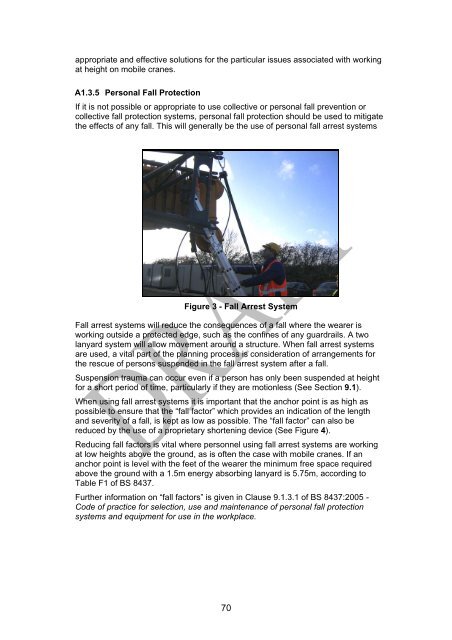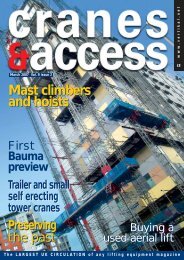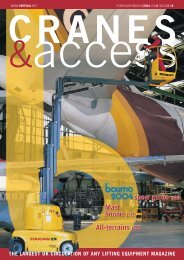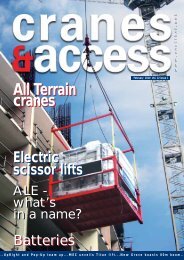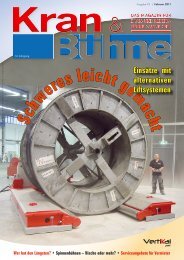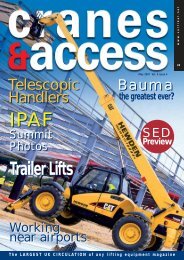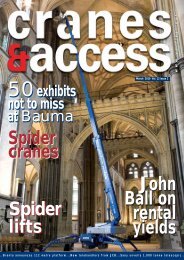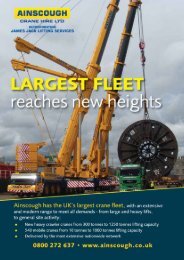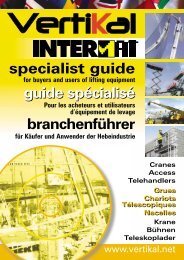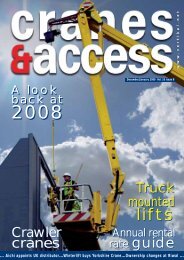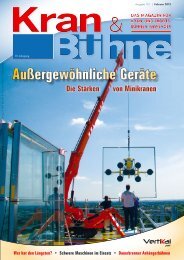Maintenance, Inspection and Thorough Examination of Mobile Cranes
Maintenance, Inspection and Thorough Examination of Mobile Cranes
Maintenance, Inspection and Thorough Examination of Mobile Cranes
Create successful ePaper yourself
Turn your PDF publications into a flip-book with our unique Google optimized e-Paper software.
appropriate <strong>and</strong> effective solutions for the particular issues associated with working<br />
at height on mobile cranes.<br />
A1.3.5 Personal Fall Protection<br />
If it is not possible or appropriate to use collective or personal fall prevention or<br />
collective fall protection systems, personal fall protection should be used to mitigate<br />
the effects <strong>of</strong> any fall. This will generally be the use <strong>of</strong> personal fall arrest systems<br />
Figure 3 - Fall Arrest System<br />
Fall arrest systems will reduce the consequences <strong>of</strong> a fall where the wearer is<br />
working outside a protected edge, such as the confines <strong>of</strong> any guardrails. A two<br />
lanyard system will allow movement around a structure. When fall arrest systems<br />
are used, a vital part <strong>of</strong> the planning process is consideration <strong>of</strong> arrangements for<br />
the rescue <strong>of</strong> persons suspended in the fall arrest system after a fall.<br />
Suspension trauma can occur even if a person has only been suspended at height<br />
for a short period <strong>of</strong> time, particularly if they are motionless (See Section 9.1).<br />
When using fall arrest systems it is important that the anchor point is as high as<br />
possible to ensure that the “fall factor” which provides an indication <strong>of</strong> the length<br />
<strong>and</strong> severity <strong>of</strong> a fall, is kept as low as possible. The “fall factor” can also be<br />
reduced by the use <strong>of</strong> a proprietary shortening device (See Figure 4).<br />
Reducing fall factors is vital where personnel using fall arrest systems are working<br />
at low heights above the ground, as is <strong>of</strong>ten the case with mobile cranes. If an<br />
anchor point is level with the feet <strong>of</strong> the wearer the minimum free space required<br />
above the ground with a 1.5m energy absorbing lanyard is 5.75m, according to<br />
Table F1 <strong>of</strong> BS 8437.<br />
Further information on “fall factors” is given in Clause 9.1.3.1 <strong>of</strong> BS 8437:2005 -<br />
Code <strong>of</strong> practice for selection, use <strong>and</strong> maintenance <strong>of</strong> personal fall protection<br />
systems <strong>and</strong> equipment for use in the workplace.<br />
70


